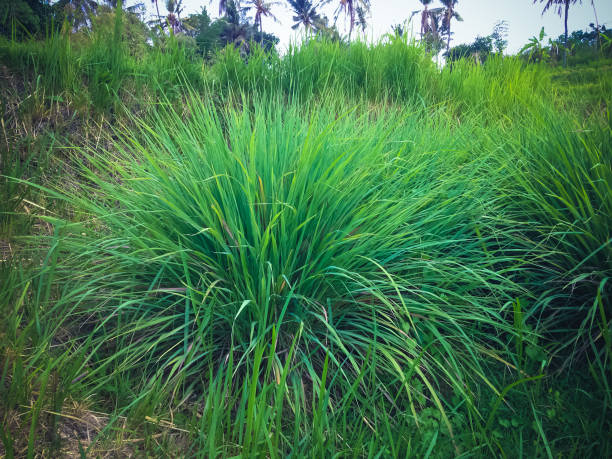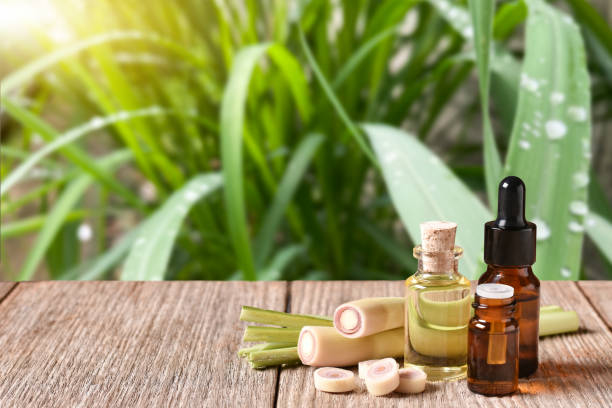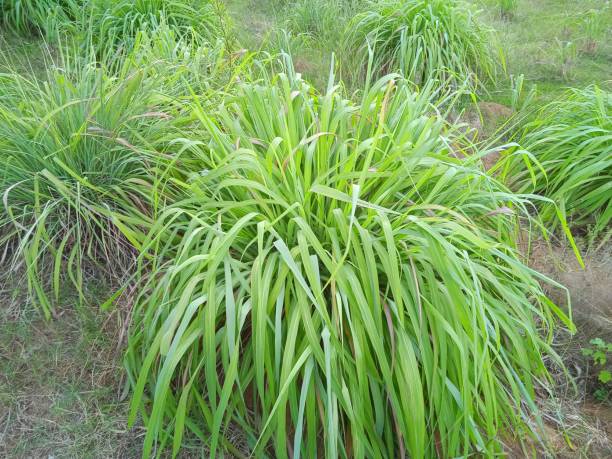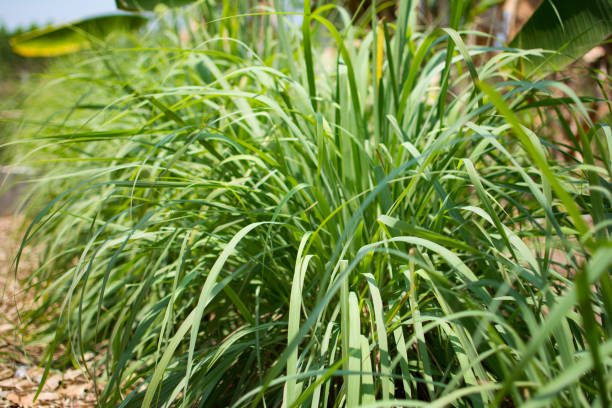Citronella Plant: Natural Mosquito Repellent in UAE & the Gulf
- Introduction to Citronella Plant
- Benefits and Uses of Citronella
- Growing Citronella in UAE and the Middle East
- Citronella Plant Care in Dubai and Gulf
- Propagation & Planting Tips
- Citronella vs Other Repellent Plants
- Conclusion
Introduction to Citronella Plant
 Citronella refers to a group of aromatic grasses in the genus Cymbopogon, with the most common mosquito-repelling species being Cymbopogon nardus and Cymbopogon winterianus. These grasses are native to tropical Asia, particularly Sri Lanka and southern India. Citronella grass grows in clumps, reaching 5–6 feet tall and several feet wide. Its leaves are long and blade-like; when bruised, they release a strong lemony fragrance that mosquitoes and many insects find offensive. Commercially, citronella oil is extracted by steam-distillation of the grass’s leaves and stems. This oil is used in many natural insect-repellent products (candles, sprays, lotions, and incense) due to its ability to confuse mosquitoes’ sense of smell.
Citronella refers to a group of aromatic grasses in the genus Cymbopogon, with the most common mosquito-repelling species being Cymbopogon nardus and Cymbopogon winterianus. These grasses are native to tropical Asia, particularly Sri Lanka and southern India. Citronella grass grows in clumps, reaching 5–6 feet tall and several feet wide. Its leaves are long and blade-like; when bruised, they release a strong lemony fragrance that mosquitoes and many insects find offensive. Commercially, citronella oil is extracted by steam-distillation of the grass’s leaves and stems. This oil is used in many natural insect-repellent products (candles, sprays, lotions, and incense) due to its ability to confuse mosquitoes’ sense of smell.
Citronella thrives in warm climates (USDA zones 10–12), which matches well with much of the UAE and Gulf region. Unlike many temperate herbs, it can often grow outdoors year-round in these areas, since winters are generally mild. (If temperatures do dip near freezing, the grass will need protection or may die back.) With long, hot summers and episodic rain, mosquito activity in the UAE rises seasonally. For this reason, local authorities even recommend planting mosquito-repellent herbs (such as basil or citronella) around homes to help reduce mosquito encounters. In the sections below, we’ll cover how to grow and care for citronella in a Middle East climate, and how it can complement other natural mosquito-control strategies.
Citronella Grass Quick Facts
- Botanical name: Cymbopogon nardus (citronella grass)
- Height & Spread: Typically 4–6 feet tall and 2–4 feet wide.
- Hardiness: USDA zones 10–12 (perennial in warm Gulf climate).
- Light: Full sun to partial shade.
- Soil: Moist, fertile, well-draining soil.
- Water: High water needs; likes evenly moist conditions (avoid dryness).
- Uses: Ornamental grass, natural insect repellent (oil extracted from leaves).
History and Botanical Background
Citronella has a long history in its native tropical Asia. It was widely cultivated in Sri Lanka, India, and other regions, where the leaves were traditionally burned or crushed to help repel insects. The word “citronella” comes from French meaning “little lemon,” reflecting the plant’s lemon-like aroma. Botanically, several Cymbopogon species produce lemon-scented oil. The main commercial species are C. nardus (sometimes called Ceylon citronella) and C. winterianus (Java citronella), each yielding oil used in perfumery and repellents. Today citronella oil is produced mainly in India, Indonesia, and China. Its use as a natural repellent was recognized by organizations like the World Health Organization (WHO), although studies note its effectiveness can be short-lived without frequent reapplication.
Benefits and Uses of Citronella
 Citronella plant is best known for its mosquito-repelling properties. Its fragrant oils work by masking the human scents (such as carbon dioxide and body odors) that attract mosquitoes. In practice, having citronella nearby can help muddle those attractant odors in the air. For example, simply brushing against a citronella clump outdoors will release a burst of lemony aroma from the leaves. Citronella oil is distilled commercially and used in many natural insect-repellent products (such as candles, sprays, lotions, and incense). The intense scent of these products is meant to confuse mosquitoes by overwhelming the carbon-dioxide cues they use to find people.
Citronella plant is best known for its mosquito-repelling properties. Its fragrant oils work by masking the human scents (such as carbon dioxide and body odors) that attract mosquitoes. In practice, having citronella nearby can help muddle those attractant odors in the air. For example, simply brushing against a citronella clump outdoors will release a burst of lemony aroma from the leaves. Citronella oil is distilled commercially and used in many natural insect-repellent products (such as candles, sprays, lotions, and incense). The intense scent of these products is meant to confuse mosquitoes by overwhelming the carbon-dioxide cues they use to find people.
Besides deterring insects, citronella offers other benefits. The plant’s oil contains mild antiseptic and anti-inflammatory compounds, which is why citronella extract appears in soaps, lotions, and aromatherapy products. In some traditional remedies, citronella has been used to soothe headaches, reduce fevers, and treat minor skin ailments, though scientific support is limited. In the garden, citronella grass itself is mainly valued for its attractive tropical foliage and practical uses; the tall, bright green clumps add texture and color to landscapes. It produces inconspicuous pale flower spikes in summer, but most gardeners remove these (they are not showy) and focus on the plant’s leafy aroma instead.
However, citronella should be seen as only one part of a mosquito control plan. Studies have shown that merely growing citronella plants has at most a modest effect on reducing mosquito numbers. For example, one gardening expert even notes that “just growing it may not repel one mosquito,” since the plant must be disturbed to release its oils. Therefore, citronella is most effective when combined with other measures: use it alongside physical barriers (window screens, mosquito nets) and personal repellents on skin, and eliminate standing water around the home as recommended by UAE health authorities. These integrated methods will maximize protection in outdoor living areas.
It’s also worth noting the limits of citronella products. For instance, citronella candles tend not to be very effective on their own, since they contain only a small amount of the actual oil. The fragrance from a candle may help locally, but it won’t clear an entire yard of mosquitoes. Nonetheless, citronella candles or torches can complement live plants by adding extra scent near seating areas.
Growing Citronella in UAE and the Middle East
The Gulf region has an arid climate with extremely hot, sunny summers and mild winters. Citronella is native to tropical areas and can handle heat, but it evolved in conditions of higher humidity and rainfall. Gardeners in Dubai or Riyadh must emulate those conditions as much as possible. Fortunately, most of the UAE and Gulf lies in USDA zones 10–11. This means that, with care, citronella can often be grown outdoors year-round. In practice, plants left outside will rarely see frost. Unlike in colder areas where citronella is an annual, in Dubai Citronella can be perennial if the nights stay above about 5°C (41°F). However, extra measures are needed in the scorching summer: many growers in the region give their plants afternoon shade to prevent leaf scorch and water generously to keep the soil moist.
Citronella plants need plenty of space and sunlight, but not the full brunt of midday sun in the hottest months. A common strategy is to plant them in a spot that gets morning sun and some afternoon shade from another plant or structure. Providing partial shade – for example, under a shade cloth or near taller shrubs – can keep plants from overheating. Mulching the soil around the base helps retain moisture and keeps the roots cooler in the intense summer heat.
Water availability is a critical factor. In the Gulf’s dry environment, citronella often requires more water than native desert plants. As a rule, outdoor citronella should be watered deeply 2–3 times a week during summer, and up to daily in containers on exposed terraces. It’s best to water in the morning or evening to reduce evaporation. Ensure excess water drains away – citronella roots must stay moist but not waterlogged. By contrast, a rainy winter season may allow for less watering during cooler months. Monitoring the soil moisture and mulching well will help manage the plant’s thirst.
Many gardeners in the UAE grow citronella in containers. This allows moving the plant to favorable spots (or indoors) and ensures consistent soil conditions. For container culture, start with a large pot (at least one gallon per plant) to accommodate its rapid growth. Even small starter plants need big pots, as the grass quickly fills space. Use a high-quality potting mix amended with organic matter. Over time, repot every 2–3 years with fresh soil to prevent root crowding. Indoor overwintering is also an option: if a cold snap threatens, place container-grown citronella in a warm, bright room. With a bit of attention, the plant can continue to grow through mild Gulf winters.
Citronella Plant Care in Dubai and Gulf
Growing Indoors
In the Gulf, citronella is usually an outdoor plant, but it can be grown indoors if given enough light. Place potted citronella near a bright, south-facing window or under grow lights that provide at least 6–8 hours of illumination daily. Indoor citronella will need regular watering and may benefit from occasional misting. Be aware that air conditioning and dry indoor air can stress the plant, so watch for drooping leaves. During winter, any outdoor plants can be moved inside to protect them from a rare cold night, as the indoor environment will keep them green until warmer weather returns.
Proper care keeps citronella healthy and fragrant. Here are the key guidelines:
- Light: Plant in bright sun or partial shade. Citronella will tolerate full sun, but in Gulf summers it may appreciate some afternoon shade. Place indoor plants where they receive at least 6 hours of sun per day.
- Soil: Use a loose, loamy, well-draining soil. Citronella needs moisture but cannot tolerate waterlogged roots. Mix compost or coconut coir into garden soil to improve water retention while maintaining drainage. Always use pots or beds with drainage holes.
- Water: Keep the soil consistently moist. Water deeply when the top 1–2 inches dry out. In practice, this means watering daily for container plants and several times per week for in-ground plants during summer. Water thoroughly (until it drains from the pot) to encourage deep roots. Slightly reduce watering in winter, but do not let the plant dry out completely.
- Temperature & Humidity: Citronella prefers warm conditions (15–30°C). It is frost-tender and will be damaged below about 0°C. Gulf winters usually stay above this, but cover or move plants indoors if an unusual cold snap is forecast. The plant also enjoys moderate humidity; in very dry indoor air or desert sun, occasional misting can help it stay lush.
- Fertilizer: Fertilize sparingly. Citronella is a heavy feeder but usually only needs one fertilizer application per growing season. In spring, mix a balanced slow-release fertilizer or organic compost into the soil. This provides nutrients for vigorous new growth. Avoid over-fertilizing, as excessive nitrogen can lead to a lush plant with somewhat weaker scent.
- Pruning: Trim dead flower spikes and any brown or leggy foliage to keep the plant tidy. Citronella clumps can be cut back by up to half in late fall or early spring. This stimulates fresh new shoots and maintains a compact shape. You can also shear the top lightly throughout the season to control size; the plant tolerates pruning well.
- Container gardening: Citronella does well in sturdy pots (start with at least 1 gallon per plant) to manage its size. Rotate containers periodically and repot every few years as needed to refresh soil and accommodate growth.
- Maintenance: Remove old flower stalks and seed heads after blooming to encourage bushier growth and to prevent self-seeding.
- Hardiness: While tolerant of Gulf heat, citronella is sensitive to frost. If nighttime temperatures near your garden approach 0°C, move container plants indoors or cover outdoor plants. In winter, water sparingly but do not let the soil dry out completely.
- Pests & Diseases: Citronella is generally pest-resistant, but watch for common issues. Root rot from overwatering is possible; ensure good drainage. Occasionally, aphids or spider mites may appear on container plants; these can be washed off with water or mild insecticidal soap. The plant’s strong scent often deters larger pests. Citronella is also known to be drought-tolerant once established.
By following these care tips in Dubai or Abu Dhabi, gardeners can keep citronella grass lush and aromatic. Healthy, well-watered plants will grow vigorously, producing abundant leaves and the maximum fragrant oil when disturbed.
Propagation & Planting Tips
 The easiest way to propagate citronella is by division, since it naturally grows in clumps. In spring or early summer, dig up a mature clump and split it into sections. Each new division should have multiple shoots and a good portion of roots. Replant each section promptly in fresh, moist soil at the same depth as before, firming the soil around it and watering thoroughly. Keep newly divided plants evenly moist; they should show new growth in a few weeks if they’ve taken root.
The easiest way to propagate citronella is by division, since it naturally grows in clumps. In spring or early summer, dig up a mature clump and split it into sections. Each new division should have multiple shoots and a good portion of roots. Replant each section promptly in fresh, moist soil at the same depth as before, firming the soil around it and watering thoroughly. Keep newly divided plants evenly moist; they should show new growth in a few weeks if they’ve taken root.
Planting Citronella – Step by Step:
- Select a location with at least 6 hours of sunlight (morning sun, light afternoon shade).
- Prepare the soil by removing weeds and mixing in compost or aged manure for fertility.
- Space each plant about 2–3 feet (60–90 cm) apart to allow room for growth.
- Dig a hole equal in depth to the root ball, place the plant, and backfill. Firm the soil gently around the base.
- Water deeply right after planting. Keep the soil consistently moist during the first few weeks.
- Apply a layer of mulch (wood chips or bark) around the base to conserve moisture and suppress weeds.
After planting, continue regular watering until new roots establish and the plant shows vigorous growth (usually within a month). Then transition to the general care routine described above to maintain a healthy citronella.
Citronella vs Other Repellent Plants
Many Gulf gardeners use a mix of aromatic plants to help deter mosquitoes. Popular choices include lemongrass, basil, lavender, mint, and marigolds, all of which produce scents or oils disliked by insects. For instance, the UAE’s climate ministry recommends planting herbs like basil and citronella around homes as a mosquito-prevention measure. These plants are an eco-friendly complement to chemical repellents; they can confuse or repel pests while attracting beneficial pollinators to the garden.
Citronella vs. Lemongrass
Gardeners should note that citronella is closely related to culinary lemongrass (Cymbopogon citratus). Both have a lemony scent, but citronella grass is considered inedible and is grown solely for its oil. Lemongrass has slender, bright green leaves and is commonly used in Middle Eastern and South Asian cooking. It also repels mosquitoes to some extent due to its citral content, but it is typically not as strong an insect repellent as citronella grass. If you purchase a “mosquito plant” without clear labeling, be cautious: many so-called citronella plants are actually lemon-scented geraniums (Pelargonium citrosum), which smell similar but contain no real citronella oil. In short, for true repellent effect, stick to the grass types of Cymbopogon.
Even with true citronella grass, gardeners should have realistic expectations. The plant’s fragrance must be released to deter bugs. As one expert notes, “just growing it may not repel one mosquito,” because the oil needs to be actively emitted. For best protection in outdoor spaces, use multiple strategies. Plant citronella alongside other repellent herbs (like basil, mint, or marigolds); use citronella candles or oils when spending time outside; and remove any standing water as advised by UAE health guidelines. In combination, these methods of mosquito management (sometimes called Integrated Pest Management) are far more effective than any single solution.
- Lemongrass (C. citratus): A close relative used in cooking; also has a lemony oil that deters insects but is primarily cultivated for culinary use.
- Basil (Ocimum basilicum): A common kitchen herb. Certain varieties (like sweet basil or lemon basil) have oils shown to repel mosquitoes. UAE authorities even mention basil as a recommended mosquito-repellent herb.
- Mint (Mentha spp.): Fast-spreading aromatic plants. Their menthol-like scent can deter flies and ants, although they are less specific to mosquitoes.
- Lavender (Lavandula): A drought-tolerant shrub with purple flowers. Its strong fragrance repels mosquitoes and many gardeners enjoy its flowers. Lavender survives Gulf winters with moderate care.
- Marigolds (Tagetes): Often planted around vegetable gardens, their scent is believed to be unappealing to some insects and their root chemicals can inhibit mosquito larvae in soil.
Conclusion
Citronella grass (Cymbopogon nardus) is a valuable addition to UAE and Gulf gardens for its fragrant foliage and mosquito-repellent properties. With proper care – ample light, consistent moisture, and routine maintenance – it will thrive in the region’s climate. Remember that citronella is a long-lived perennial in these warm zones. It will form dense clumps over time but remains a clumping grass (it does not aggressively spread). You can manage its size by trimming yearly. A healthy citronella plant will grow larger each year, providing more aromatic leaves when disturbed.
To reduce mosquitoes effectively, combine citronella planting with other practices: use window screens and protective clothing, apply repellents to skin as needed, and eliminate any standing water where mosquitoes breed. By integrating citronella with these measures (and planting companion herbs like basil and lavender), residents in Dubai, Abu Dhabi and across the Gulf can enjoy their patios and balconies with fewer insect interruptions. For more detailed guidance, see our related AAAKSC guides: Growing Citronella Plant in Home Garden and Plants That Repel Mosquitos Naturally.






Leave a Reply